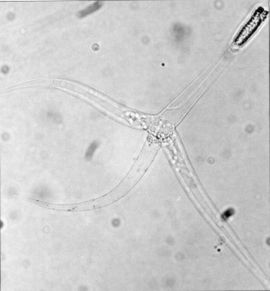Myxozoa facts for kids
Quick facts for kids Myxozoa |
|
|---|---|
 |
|
| Triactinomyxon stage of Myxobolus cerebralis. | |
| Scientific classification | |
| Kingdom: | |
| Phylum: | |
| (unranked): |
Myxozoa
Grassé, 1970
|
| Classes | |
|
|
The Myxozoa are tiny, often microscopic, animals that live as parasites inside other aquatic animals. They are found in water environments like oceans, rivers, and lakes. Some Myxozoa, like Myxobolus cerebralis, can cause diseases in fish that people eat. This can be a big problem for fish farms.
Over 1300 different species of Myxozoa have been discovered. Many of them have a special life cycle that involves two different hosts. This means they need two different animals to complete their life journey.
Contents
What are Myxozoa?
Myxozoa are a unique group of animals. They are so small that you usually need a microscope to see them. They are known for being parasites, which means they live inside another living thing, called a host, and get their food from it.
These tiny creatures live in watery places. You can find them in oceans, rivers, and even lakes. Some Myxozoa can cause serious problems for fish. For example, Myxobolus cerebralis attacks fish like trout and salmon.
Their Amazing Life Cycle
Many Myxozoa have a fascinating and complex life cycle. It often involves two different hosts. One host is usually a fish, and the other is often an annelid worm or a bryozoan. Bryozoans are tiny water animals that often live in colonies.
The Myxozoa will spend part of their life inside the fish. Then, they will move to the worm or bryozoan to continue their development. This two-host system helps them spread and survive in different environments.
How Scientists Classified Them
For a long time, scientists thought Myxozoa were a type of protozoa. Protozoa are very simple, single-celled organisms. However, new research has changed this idea.
Scientists now know that Myxozoa are actually part of the phylum Cnidaria. This group includes animals like jellyfish, sea anemones, and corals. This was a big surprise because Myxozoa look so different from jellyfish!
Researchers studied the genes of a Myxozoa called Buddenbrockia. They looked at 50 different genes. The results showed that Myxozoa are indeed related to Cnidaria. They are just very changed versions of them, adapted to a parasitic life.
One clue that helped scientists was the similarity between Myxozoa's 'polar capsules' and the stinging cells of Cnidarians, called nematocysts. For a long time, scientists thought this similarity was just a coincidence. They called it convergent evolution, meaning two different groups developed similar features independently. But now, it's clear they share a common ancestor.
Images for kids
See also
 In Spanish: Mixozoos para niños
In Spanish: Mixozoos para niños


